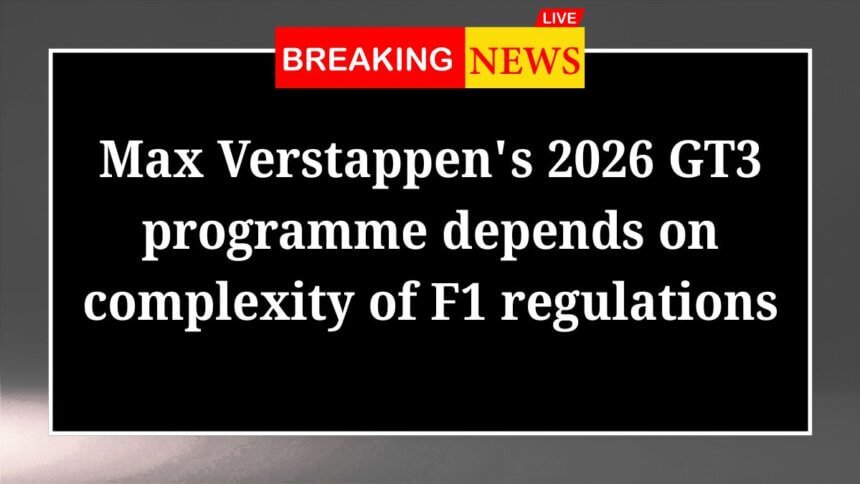Max Verstappen’s 2026 GT3 Programme: A Future Formed by F1 Rules
Max Verstappen, the reigning Method 1 world champion, is eyeing a possible enterprise into the GT3 racing class by 2026. This ambition, nonetheless, is intricately linked to the evolving complexities of Method 1 laws. As groups and drivers adapt to new guidelines, Verstappen’s aspirations hinge on how these laws will impression his skill to compete in different racing codecs.
- Max Verstappen’s 2026 GT3 Programme: A Future Formed by F1 Rules
- Who’s Max Verstappen?
- What’s GT3 Racing?
- Why the Complexity of F1 Rules Issues
- The Implications of the 2026 Rules
- The Path to GT3: What Must Change?
- The Position of Group Dynamics
- Trade Reactions and Future Prospects
- A Information-Pushed Future
- The Monetary Elements of GT3 Racing
- The World Attraction of GT3 Racing
- FAQ
Who’s Max Verstappen?
Max Verstappen, a Dutch racing prodigy, burst onto the Method 1 scene in 2015. By the age of 17, he grew to become the youngest driver to compete in a Method 1 race. Since then, he has risen to prominence, securing a number of championships with Purple Bull Racing. His driving prowess and aggressive spirit have made him a family title in motorsport, and his potential shift to GT3 racing has captured the eye of followers and business professionals alike.
What’s GT3 Racing?
GT3 racing options modified street vehicles that compete in numerous worldwide sequence. In contrast to Method 1, which focuses closely on expertise and aerodynamics, GT3 emphasizes efficiency parity amongst opponents. Every automotive is constructed to satisfy particular technical laws, permitting for a various vary of makes and fashions. This class has gained reputation for its accessibility and thrilling racing, making it a fascinating possibility for drivers seeking to increase their careers.
Why the Complexity of F1 Rules Issues
The complexity of Method 1 laws is a big consider Verstappen’s decision-making relating to his GT3 aspirations. As the game evolves, groups like Purple Bull Racing are frequently adapting to new guidelines that govern efficiency, security, and environmental issues. For instance, the introduction of hybrid engines and the push for sustainable racing practices have reshaped the panorama of F1. In keeping with a report by the FIA, the governing physique of motorsport, regulatory adjustments will proceed to be applied to enhance sustainability and competitors in Method 1. These laws can have an effect on a driver’s availability and efficiency, which might affect their participation in different racing codecs like GT3.
The Implications of the 2026 Rules
As F1 heads in the direction of 2026, new laws are anticipated that would reshape the aggressive panorama. These adjustments might embody developments in hybrid expertise and a higher emphasis on vitality effectivity. For Verstappen, the extent to which these laws complicate the F1 setting will play a vital function in figuring out if he can decide to competing in GT3 racing. Verstappen himself has acknowledged the complexity of the present regulatory setting. In a current interview, he talked about, “The extra sophisticated the principles turn out to be, the tougher it may be to stability commitments throughout completely different racing codecs.” This displays his understanding of the intricate relationship between F1 and his potential involvement in GT3.
The Path to GT3: What Must Change?
For Verstappen to make a profitable transition to GT3 racing, a number of elements should align. First, he might want to assess his commitments to Purple Bull Racing and decide if there’s a possible window to take part in GT3 occasions. Moreover, the efficiency of the automotive he would race in GT3 have to be aggressive throughout the class’s laws. Moreover, Verstappen’s expertise in F1 may very well be a double-edged sword. Whereas his abilities and data of racing dynamics can be invaluable in GT3, the difference to a much less technologically superior car could current challenges. The flexibility to modify gears from the high-speed precision of F1 to the endurance and technique concerned in GT3 would require an adjustment interval.
The Position of Group Dynamics
Group dynamics may even play a pivotal function in how Verstappen navigates his potential transfer to GT3. Purple Bull Racing’s management might want to assist his want to discover alternatives exterior of Method 1. Because the workforce gears up for the 2026 season, the willingness of administration to accommodate Verstappen’s ambitions might considerably affect his resolution. Moreover, the prevailing workforce tradition and the relationships between drivers and engineers will have an effect on the feasibility of collaborating in GT3 occasions. Collaborative assist from Purple Bull might make a big distinction in facilitating Verstappen’s twin racing aspirations.
Trade Reactions and Future Prospects
The motorsport neighborhood is watching Verstappen’s scenario carefully. Analysts and followers alike are intrigued by the prospect of seeing the F1 champion compete in GT3. The potential for such a crossover has sparked discussions about the way forward for motorsport and the methods wherein drivers can diversify their careers. As famous by motorsport analyst James Allen, “The rise of GT racing as a platform for F1 drivers is a testomony to the game’s evolution and the rising alternatives for drivers to showcase their skills throughout numerous disciplines.” This attitude underscores the rising development of drivers exploring completely different racing codecs, enhancing their visibility and marketability.
A Information-Pushed Future
The info surrounding driver efficiency and car functionality will play an important function in shaping Verstappen’s selections. The FIA’s evaluation of efficiency metrics throughout numerous racing codecs could function a benchmark for Verstappen as he evaluates his choices. The flexibility to leverage information analytics in decision-making can be essential as he contemplates his future in motorsport.
The Monetary Elements of GT3 Racing
Whereas the attract of GT3 racing is robust, the monetary implications can’t be neglected. Competing in GT3 can contain substantial prices, together with automotive improvement, workforce bills, and entry charges in numerous sequence. The monetary mannequin of GT3 is completely different from F1, the place sponsorships and workforce budgets can overshadow particular person driver earnings. As a outstanding determine in motorsport, Verstappen’s potential involvement in GT3 might additionally appeal to new sponsors seeking to affiliate their manufacturers with a profitable picture. This might present monetary backing not just for him but in addition for a GT3 workforce that is perhaps desirous about leveraging his presence on the grid.
The World Attraction of GT3 Racing
GT3 racing just isn’t confined to Europe; it has a world attraction, with sequence operating in North America, Asia, and Australia. This worldwide presence permits drivers like Verstappen to showcase their abilities on different tracks and in several racing cultures. For Verstappen, transitioning to GT3 might improve his profile additional, opening doorways to markets that Method 1 doesn’t totally attain.
FAQ
Q: What’s Max Verstappen’s present standing in Method 1? A: Max Verstappen is the reigning Method 1 world champion, competing for Purple Bull Racing. Q: What’s GT3 racing? A: GT3 racing options modified street vehicles competing in numerous sequence, emphasizing efficiency parity and accessibility. Q: How do F1 laws impression Verstappen’s potential transfer to GT3? A: The complexity of F1 laws could have an effect on Verstappen’s commitments to his workforce, influencing his skill to take part in GT3 occasions. Q: What elements will affect Verstappen’s resolution to enter GT3 racing? A: Key elements embody his commitments to Purple Bull Racing, the efficiency of GT3 autos, workforce dynamics that assist his ambitions, and the monetary implications of competing in GT3. Q: How does the recognition of GT3 racing profit drivers? A: GT3 racing’s international attraction permits drivers to showcase their abilities internationally, attracting sponsors and offering alternatives to diversify their careers past Method 1.






